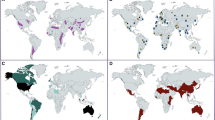Abstract
The selectivity of enamel caps, and specimens of a synthetic hydroxyapatite powder dispersed within a poly(methylmethacrylate) matrix, to K+ transport in KCl concentration cells has been examined before and after a 24-hour application of 1.0 M KF at its natural pH. The membrane potentials after this treatment were in general higher, the elevation increasing as the concentration gradient was increased. It is concluded that the results are consistent with the hypothesis that enamel acts as an ion-exchange membrane and it is suggested that with KCl solutions the effective fixed negative charge density associated with the surfaces of the hydroxyapatite crystallites along the diffusion pathways may be increased by a topical fluoride treatment and may induce a higher cationic selectivity to the structure.
Résumé
La spécificité de coiffes d'émail et de specimens de poudre synthétique d'hydroxyleapatite, dispersée dans une matrice de poly(methylméthacrylate), vis à vis du transfert de K+ dans des chambres à concentration de KCl, a été étudiée avant et après application pendant 24 heures de 1.0 M KF à pH normal. Les potentiels de membrane après ce traitement sont généralement plus élevés, l'augmentation se faisant avec l'élévation du gradient de concentration. Ces résultats emblent indiquer que l'émail agit comme une membrane échangeuse d'ions. Il semble que la densité des cristaux d'apatite, le long des voies de diffusion, peut être augmentée par un traitement local de fluor et peut induire une spécificité cationique plus élevée.
Zusammenfassung
Die Schmelzschicht eines Zahnes, sowie Proben von synthetischem, in einer Poly(methylmethacrylat)-Matrix verteiltem Hydroxyapatitpulver wurden wie folgt untersucht: ihre Selektivität auf K+-Transport in Meßzellen mittels KCl-Konzentrationsgradienten wurde vor und nach einer 24stündigen Behandlung mit 1,0 M KF bei pH 7,6 geprüft. Die Membranpotentiale waren nach dieser Behandlung im allgemeinen höher; die Erhöhung nahm mit dem Konzentrationsgradient zu. Daraus wird geschlossen, daß die Ergebnisse mit der Hypothese, wonach Schmelz als Ionenaustausch-Membran wirken kann, übereinstimmen und es wird vorgeschlagen, daß mit KCl-Lösungen die wirksame fixierte Ladungsdichte auf den Oberflächen der Hydroxyapatitkriställchen entlang den Diffusionsbahnen durch lokale Fluoridbehandlung erhöht werden kann und dadurch eine höhere Kationenselektivität auf die Struktur ausübt.
Similar content being viewed by others
References
Armstrong, W. D., Singer, L.: Lack of effect of fluoride on permeability of enamel. J. dent. Res.31, 493 (1952).
Berggren, H., Hedström, H.: The influence of topically applied fluorine on the permeability of enamel. J. dent. Res.30, 169–171 (1951).
Brudevold, F., McCann, H. G., Nilsson, R., Richardson, B., Coklica, V.: The chemistry of caries inhibition. Problems and challenges in topical treatments. J. dent. Res.46, 37–45 (1967).
Brudevold, F., Soremark, R.: Chemistry of the mineral phase of enamel. Chap. 18. in structural and chemical organization of teeth, vol. II., ed. Miles, A. E. W.. New York-London: Academic Press 1967.
Chick, A. O., Waters, N. E.: Membrane potential in teeth: Application of some common anions to enamel. J. dent. Res.42, 932–942 (1963).
Duckworth, R., Braden, M.: The uptake and release of fluorine-18 by human intact surface enamelin vitro. Arch. oral Biol.12, 217–230 (1967).
Helfferich, F.: Ion-exchange. New York: McGraw-Hill 1962.
Leach, S. A.: Some notes on the solubility of enamel and dentine in acid. Arch. oral Biol.1, 218–232 (1960).
Somasundaran, P.: Zeta potential of apatite in aqueous solutions and its change during equilibration. J. Colloid Interface Sci.27, 659–666 (1968).
Spinelli, M. A., Brudevold, F., Moreno, E.: Mechanism of fluoride uptake by hydroxyapatite. Arch. oral Biol.16, 137–203 (1971).
Waters, N. E.: Physico-chemical studies of membrane phenomena in human dental tissues. Ph.D. thesis, University of London (1968).
Waters, N. E.: A cell for membrane and diffusion studies across enamel sections. Arch. oral Biol.15, 267–269 (1970).
Waters, N. E.: The selectivity of human dental enamel to ionic transport. Arch. oral Biol.16, 305–322 (1971).
Author information
Authors and Affiliations
Rights and permissions
About this article
Cite this article
Waters, N.E. The electrochemical behaviour of human dental enamel after topical fluoride treatment. Calc. Tis Res. 10, 314–322 (1972). https://doi.org/10.1007/BF02012562
Received:
Accepted:
Issue Date:
DOI: https://doi.org/10.1007/BF02012562




